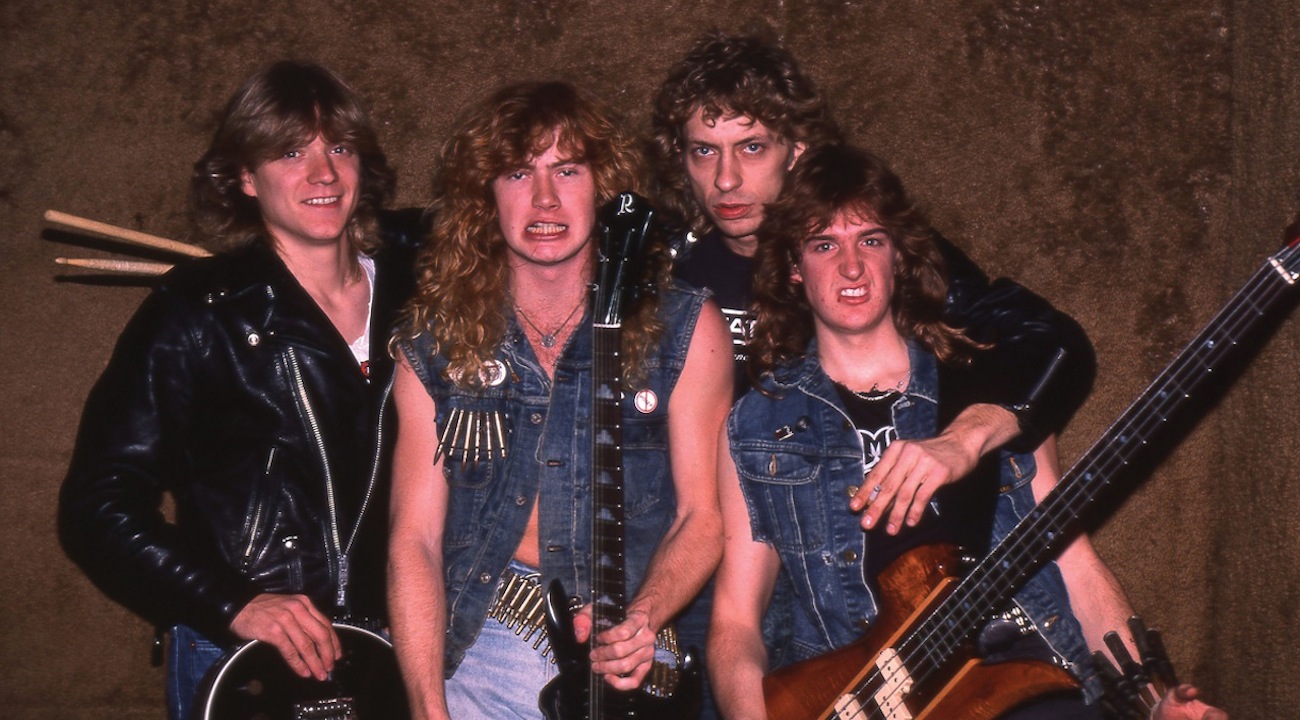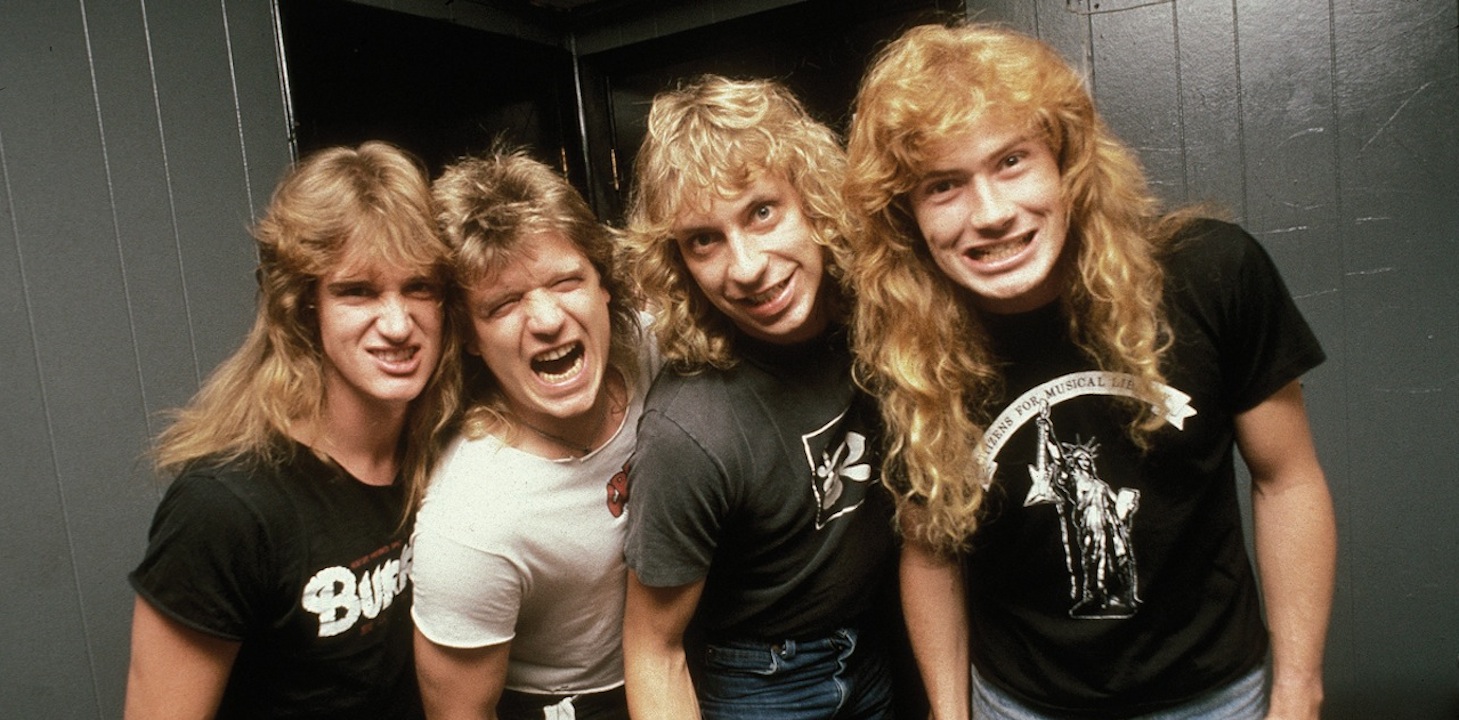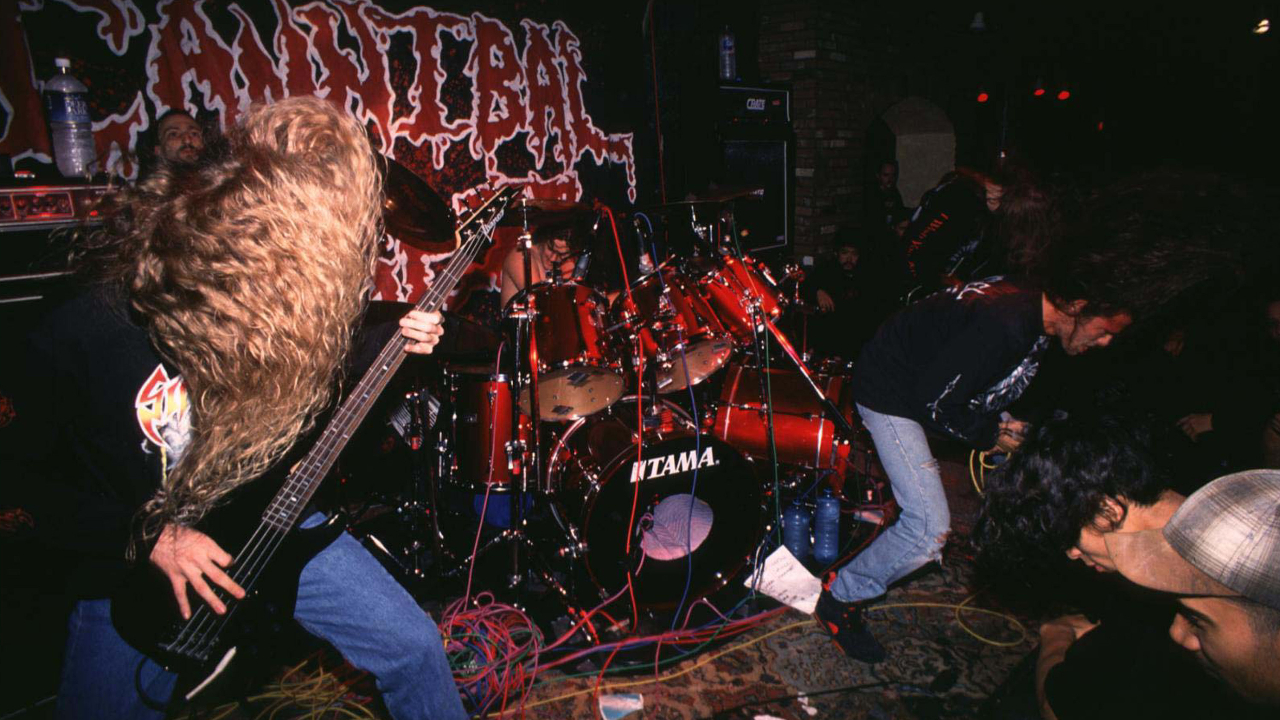Megadeth’s Killing Is My Business: hamburgers, heroin and one of metal’s greatest debut albums
Fired from Metallica and seeking revenge, Dave Mustaine brought Megadeth screaming to life. Here, the band open up on their landmark debut and spending $4,000 on coke, heroin and hamburgers

At 10am on April 11, 1983, Dave Mustaine was awoken from his sleep on the floor of the Music Building rehearsal rooms in Queens, NY, and informed by James Hetfield, Lars Ulrich and Cliff Burton that he was no longer in Metallica.
“What, no warning? No second chance?” the guitarist asked.
“No,” said Lars Ulrich. “It’s over.”
The drummer handed Mustaine an envelope: inside was a one-way bus ticket to San Francisco, valid for a Greyhound Lines coach scheduled to leave New York at 11am.
“Get your stuff,” said Ulrich. “You’re leaving right now.”
On the four-day journey, Mustaine had plenty of time to reflect upon exactly what he had done to merit this indignity. As the bus rolled across state lines, thoughts of vengeance kept him awake. He would return, he vowed, with a new band; one louder, harder, faster and more brutal than his former group – a group that would crush Metallica’s dreams as surely as it would elevate Mustaine to glory.
“I was out for blood,” the guitarist later admitted. “Theirs.”
Sign up below to get the latest from Metal Hammer, plus exclusive special offers, direct to your inbox!
Today, ensconced in the Franklin, Tennessee, recording facility where Megadeth are at work on their 15th studio album, Dave Mustaine laughs dryly when reminded of that quote.
“At the time, that was the idea,” he admits, “but that’s the kind of thing you say as a young man when you’re mad. I never wanted to hurt those guys. In retrospect, I get it: if you’ve got a guy that gets violent when he gets drunk, and he’s kinda drunk 24⁄7, then having him around you all day long probably isn’t good for business. I would have done the same thing [as they did]. I had a problem with alcohol, and it cost me my job and cost me two very dear friends. But I didn’t have a Plan B. Being a successful musician was all I ever wanted, and I wasn’t going to let that dream die.”
With additional commentary from Megadeth bassist David Ellefson and former guitarist Chris Poland, this is the uncensored story of Killing Is My Business…, and how Dave Mustaine brought his dream to life.

In the summer of 1983, Mustaine moved back to LA and began to seek out musicians capable of helping him realise what he firmly believed to be his destiny.
Mustaine: “When you’re young and have fire in your belly and you want to do something new, you’re willing to go to any lengths to make it work. And I was fired up, because I told Metallica not to use any of my songs and then four of them appeared on Kill ’Em All. I went through quite a few people – [guitarist] Robbie McKinney, [bassist] Matt Kisselstein, a lot of drummers. Then I met David Ellefson…”
David Ellefson: “Dave was living with his roommate, Tracy, in the apartment above me at 1736 North Sycamore Avenue in Hollywood. I hadn’t heard of Metallica, so I had no knowledge of Dave’s history, but my first impressions of him was that he was overwhelmingly magnetic. He had the same larger-than-life, not-of-this-world charisma that I’d seen before in guys like David Lee Roth, who for an American teenager growing up in the 70s was the epitome of a rock god. And the music that he was writing was completely new, refreshing, unique, totally compelling and very heavy.”
Mustaine: “I knew David would work because he had the attitude, the look, the ability, and the drive. I told him, ‘In this business, you have to eat shit, smile and ask for more.’ Not everyone can accept that.”

As the summer ceded to autumn, a succession of musicians passed through East Hollywood’s Mars rehearsal studio to jam with Mustaine and Ellefson. Most were swiftly shown the door. When vocalist Lawrence ‘Lor’ Kane failed to meet the duo’s exacting standards, a frustrated Mustaine took on vocal duties (“I didn’t want to sing,” he maintains. “I wanted to be one of the greatest guitar players in the world”).
Though a stable lineup had yet to coalesce, Megadeth were amassing a formidable arsenal of songs, so in February 1984 Mustaine booked his band some shows in San Francisco, keen to show his Bay Area ’Banger friends that he was back. Still lacking a second guitarist, the singer asked Slayer’s Kerry King to sit in for the gigs. Billed on flyers as ‘Skull Splitting Metal’, the quartet (rounded out by drummer Lee Rausch) stormed into Metallica’s backyard for shows at Ruthie’s Inn and The Stone, and blew the locals away. Three more thrillingly violent Bay Area shows in April confirmed that Megadeth were the fiercest, most feral new band on the nascent thrash scene.
Mustaine: “People were excited about what we were doing. But Kerry couldn’t join because he was in Slayer, and when we came home Lee disappeared, so we were screwed again.”

That Metallica had by now released Ride The Lightning, featuring two Mustaine co-writes – the title track and instrumental The Call Of Ktulu – did little to lift Megadeth’s spirits. Enter an unlikely hero. Jay Jones was a minor league Hollywood music industry ‘face’ with connections in both the LA hardcore punk scene and the hip-hop community. He was also a drug dealer. Jones liked Mustaine’s attitude and swagger, and saw potential in his music. He offered to manage the band, found Mustaine and Ellefson a place to live, kept them fed and watered and filled their heads with grand schemes while serving up a steady diet of hard drugs. He also introduced the pair to their new drummer, Gar Samuelson, and guitarist Chris Poland, who had previously shared stages in jazz-fusion band the New Yorkers.
Mustaine: “I didn’t like Gar at first because he didn’t look metal, but when he started playing I was like, ‘Wow. This really highlights the intricacies of my riffs and picking style.’ We started playing as a three-piece, and then Jay introduced us to Chris. I was apprehensive about him, too, but when I heard him play I thought, ‘He’s a brilliant musician.’”
Poland: “Dave hit the jackpot when he met Gar. He had swing. He was a huge Who and Zeppelin fan, but he was a jazz guy: no one else in that scene listened to jazz drummers. He brought an element to that music that no one else has brought to metal to this day.
“Gar told me they were looking for another guitarist and said I should just go down to Mars studios and rent a room, set up my stuff and play really loud. So I did, and Dave walked in and asked me to join the band. He was drunk.”
Ellefson: “It was not easy for us to pull together musically because we were four very separate-sounding musicians. Gar was Billy Cobham and Keith Moon, Chris was coming from a John McLaughlin jazz-fusion thing, and Dave and I were the hard rock, heavy metal, punk guys. But some real musical fortitude came out of it.”
Poland: “I didn’t dislike the music, but initially I wasn’t quite getting it. But once I started playing I realised it was pretty intricate and challenging, and I liked that. About three weeks after we started rehearsing, we went into the studio to make the first album.”

The band had secured a record deal with New York’s Combat label on the strength of a demo. Given an $8,000 budget for an album, Jones and recording engineer Karat Faye scored a $50/day rate at Indigo Ranch studios in Malibu, a beautiful facility owned by former Moody Blues keyboard player Mike Pinder. For a bunch of Hollywood street rats, squatting in properties devoid of electricity, it looked like paradise. Certain members of the band got carried away with these newly improved circumstances…
Ellefson: It was a great studio, 40 miles away from any distractions. But as soon as we arrived, it was like, ‘Shit, how are we gonna get drugs?’”
Mustaine: “I got to the studio one day and Jay told me the others had spent $4,000 on coke, heroin and hamburgers. I was like, ‘Are you out of your fucking mind?’”
Ellefson: “There was a major heroin issue. Dave and I were more pot and beer, but we’d do coke and heroin if you gave it to us. Others had serious addictions. Hollywood in ’83, ’84 was the epitome of sex, drugs, rock’n’roll and decadence, and we were further on the edge than most.”
Poland: “Everyone knew I was doing that stuff before I joined. We were all doing $80-$100 of heroin a day. It was out of control, but I don’t remember ever being too sick to play.”

The sessions at Indigo were productive. Jettisoning Jay as executive producer, Mustaine placed his trust in Faye, an engineer who’d worked with everyone from Kiss to Rod Stewart. In addition to re-recording the tracks from their demo – Loved To Deth, Skull Beneath The Skin and Mechanix, a song Mustaine had previously recorded with Metallica on their 1982 Power Metal demo – the group tracked four new Mustaine originals (Rattlehead, Chosen Ones, Looking Down The Cross and the album’s proposed title track, Killing Is My Business… And Business Is Good), plus a spirited version of Nancy Sinatra’s 1966 hit single, These Boots Are Made For Walkin’.
Mustaine: “I remember that song blasting from my parents’ car radio as a kid. Jay said we should do Frank Sinatra cover, but I said I’d prefer to do These Boots… It was a bit cooler because back then you had all the punkers wearing Doc Martens, stomping and moshing.
“The song Killing Is My Business… still stands up well. I was reading a comic book called The Punisher, and I thought it was cool that it had this twist whereby you’d paid someone to kill somebody and then they come back and go, ‘By the way, someone has paid me to kill you.’ Loved To Deth was a ‘boy-falls-in-love-with-girl, girl-doesn’t-love-boy, boy-kills-girl’ story. A lot of kids understand that ‘If I can’t have you, no one will’ mentality.
“Looking Down… had to do with my guilt about being brought up with religion, and Jehovah’s Witnesses’ attempts to brainwash me. Skull Beneath The Skin was inspired by a book cover I saw when I was shoplifting in a grocery store. Rattlehead came to my mind when I was at the Reseda Country Club in LA watching bands and looking for chicks: I remember thinking about leather and spikes and making the music fast and loud, back to where I started, no Plan B.”
Ellefson: “We did the takes quickly, with Dave, Gar and I in one room, playing together, with no click tracks. You can hear the tempos shifting around, depending on whether it was a ‘heroin take’ or a ‘cocaine take’. It’s funny now, but I wouldn’t recommend that approach.”
Megadeth delivered the album to Combat in January 1985. In the weeks that followed, Mustaine would rise each day at 7am to call the label’s East Coast office as it opened, enquiring about the album’s cover art. He had a clear vision of what he wanted: a dark and macabre image based around an idea he’d conceived for an Eddie-style band mascot, Vic Rattlehead.
Mustaine: “The original inspiration for Vic came from a little model of the Speak No Evil, See No Evil, Hear No Evil monkeys that my mom had. I thought it’d be cool to translate that to metal, so I drew it and got my friend Peyton Tuttle to paint it for our first t-shirt. The cover was supposed to be based on his painting, with a shield and knives and chains and a skull and crossbones…”
Ellefson: “So this box shows up and we open it and there’s the record. Dave was immediately on the phone to Combat, asking, ‘What the fuck is this?’”
Mustaine: “It was a plastic skull with tinfoil and ketchup. It was shit.”
Ellefson: “We were mortified. That artwork was supposed to be the DNA of everything Megadeth was about. But it did do one thing: it made us realise that it was truly us against the world.”

Killing Is My Business… And Business Is Good was released with little fanfare on June 12, 1985. Two weeks later, Megadeth set off on their first US tour… minus Chris Poland, who was struggling with his addictions. As pissed off as Mustaine was with his fellow guitarist, he was elated that his band were finally on their way…
Mustaine: “There were comments good and bad about the record but I didn’t care. All I knew was that I had stuck my flag in the ground and from then on we were going out with all guns blazing.”
Ellefson: “I listen back to that album and I can see what the fans love about that lineup. Megadeth then was like [American jazz fusion band] Weather Report meets the Sex Pistols: I love the musical virtuosity of what we did, but also the punk rock spirit.”
Mustaine: “They say anger and rebellion is a young man’s game, and I was definitely an angry young man. But when I listen to Killing… I hear a freshness and energy: we were doing stuff no one had done before, in terms of tempo and modulations and that darkness.”
Poland: “Sonically I didn’t like it. The energy was there, but it should have been better.”
Ellefson: “It could have sounded better for sure, and there are mistakes on the record, but it’s an honest document of where we were at the time. Being homeless and starving, the drugs and alcohol, all that fed into the package. Life then just sucked on every level, except when we were in a room as a band. Those were the hours when you could just turn the world off. As long as the four of us were in a room together, there was hope, and that’s what that record is about: the sound of hope. And that’s part of the reason it’s influenced and inspired three generations of metalheads.”

A music writer since 1993, formerly Editor of Kerrang! and Planet Rock magazine (RIP), Paul Brannigan is a Contributing Editor to Louder. Having previously written books on Lemmy, Dave Grohl (the Sunday Times best-seller This Is A Call) and Metallica (Birth School Metallica Death, co-authored with Ian Winwood), his Eddie Van Halen biography (Eruption in the UK, Unchained in the US) emerged in 2021. He has written for Rolling Stone, Mojo and Q, hung out with Fugazi at Dischord House, flown on Ozzy Osbourne's private jet, played Angus Young's Gibson SG, and interviewed everyone from Aerosmith and Beastie Boys to Young Gods and ZZ Top. Born in the North of Ireland, Brannigan lives in North London and supports The Arsenal.
